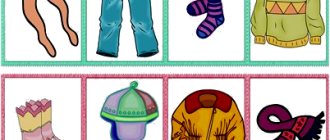Learning colors: where to start
The ability to distinguish colors refers to the concept of visual information. To make the perception of visual information more productive and successful, you need to follow simple steps that every mother and her child can do.
- You need to start learning with 4 primary colors: blue, red, green, yellow. The main task is to teach the baby to differentiate these colors so that the child can select the necessary cubes of the same color; separate the red balls from the blue ones; build a “turret” from cubes of one of the colors.
- Be sure to focus on colors whenever possible. “Look what a RED apple”, “And this is a GREEN ball”, “Let's build a pyramid from BLUE rings”, etc.
- As you learn primary colors, gradually add 2 new complex color shades to your training. Include the most common colors in your study: orange, purple, pink. The child remembers the brighter color first.
How to determine color blindness in a baby?
In early childhood, it is almost impossible to make a definitive diagnosis. Until a child can name colors himself, one can only suspect a color vision disorder.
As soon as the child has mastered the names of colors and learned to distinguish them (3-5 years), special tests can be carried out, based on the results of which the ophthalmologist can conclude about the presence or absence of pathology.
How tests work
Tests to detect color blindness consist of bright, multi-colored pictures or figures that a healthy person can easily identify against a background of a different color. For a child with a pathology, this task will be impossible: he will either name the colors incorrectly or see a uniform pattern.
Other forms of tests are aimed at distinguishing shades. The patient is offered a stand with chips of different shades, which must be placed in a certain order. A person with color blindness will not be able to organize the chips: there will be no smooth transition of colors.
In other words, the principle of the tests is to highlight some shades against the background of others.
Rabkin test plates
Rabkin's test plates are the most common test for identifying color blindness. It consists of 27 cards depicting numbers or figures of small circles of one color against a background of circles of a different color.
The ophthalmologist shows the tablets to the child one by one, and his task is to name the correct number in a short time. In the case of young children who do not yet know numbers, they can show the outline of the number with their finger.
If a baby has color blindness, he will either not distinguish numbers at all, or will name other numbers. One error already indicates the presence of deviations, and then the ophthalmologist uses a control test, during which the type of color blindness can be determined.
Stilling and Ishihara color schemes
The Ishihara test is in many ways reminiscent of Rabkin's tablets. For diagnostics, they also use plates with numbers made up of circles of different colors and sizes, which need to be named or shown, or the trajectory of the depicted line must be tracked.
In the Ishihara test, there are also pictures that do not have numbers, but people with color vision impairment can see them.
Stilling's color schemes follow the same principle.
Spectral forms of diagnostics
Spectral forms of diagnostics are relatively young. They involve the use of special equipment, for example, the Girenberg and Abney apparatus. In practice, spectroanomaloscope devices are used.
Mom and baby: techniques for teaching colors at home
First of all, you should remember that teaching colors should only take place in a playful way. Unobtrusive, light, but daily exercises with the baby will give positive results after 3-5 days.
Pay attention to teaching methods for children from 2 to 5 years old that will help your child understand and master the basic colors of the palette.
– Plasticine
Oddly enough, working with ordinary plasticine can give excellent results in mastering colors and their shades. Standard plasticine will include the necessary colors for study: red, green, yellow, blue, orange. A 2-year-old child, under the guidance of his mother, can work every day with several colors, making only red or green balls, making blue snowmen. If you see that the baby in the game begins to highlight one bright, common color, for example, green, then reinforce the work with him by telling him what objects of this color are, and demonstrate them.
– “Colorful” days
This technique was developed by American physiotherapist, author of many training techniques, Glen Doman. Studying colors by day of the week is a good way to learn and reinforce knowledge about a specific color. For example, Monday is a red day. Today the baby should be surrounded by red things. Introduce him to red vegetables and fruits. Draw red patterns in watercolors and cut out red shapes from colored paper on this day. By analogy, introduce your baby to other colors: green, blue, etc.
We teach by playing
Children concentrate their attention while playing; it is while playing that the child begins to perceive information and also remember colors. For example, when playing with a 2-3 year old toddler, you can ask him to give him any brightly colored toy.
Of course, if there are too many toys around, it will be difficult for the baby to navigate, so you should help him by pointing at the desired object with your finger, again voicing your request.
Such training is important for children, because they begin to remember colors, as well as shapes, through individual contact with an object. After 5 minutes, when the baby has rested, you can repeat the lesson, but ask him to pass a toy of a different color, this way he will be able to learn the main colors.
Thanks to this technique, it is possible to develop not only visual memory, but also fine motor skills in children. At the age of 2-3 years, the toddler quickly remembers, so with regular training he will know all the colors.
The main thing is to carry out the learning process “unnoticed” for the kids, that is, while playing, the children will not even understand that their parents are starting a lesson, but will enthusiastically do what the adults suggest.
Even the process of dressing can bring excellent results and allow you to learn the colors of clothes. Invite your toddler aged 2-3 years to wear, for example, a blue or green sweater. If your child agrees, ask him to bring the selected clothes from the closet.
Today, there are a lot of entertaining and educational games on how to teach a child to distinguish colors, but you can teach him simple skills without any material costs.
For children 2 or 3 years old, communication with adults is of great importance, so you should prefer simple, accessible joint entertainment to specialized games.
Consequences
Over time, if parents correctly approach the development and communication with a colorblind child, the child will learn to live with his peculiarity and will no longer consider himself worse than others. In everyday life, he will also learn to adapt to situations. For example, before a pedestrian crossing, he can focus on a crowd of people who are starting to cross the road when all the cars have stopped, or he can ask for help from others.
REFERENCE. In cases of possible danger (for example, eating a spoiled product or a berry of the wrong color), the child should not rely on his color perception, which parents should warn him about. It is better if the colorblind person seeks help from other people.
Among the most unpleasant consequences of color blindness are the inability to obtain a driver's license and restrictions on military service. In Russia, people with any form of pathology are deprived of the opportunity to drive a vehicle.
Restrictions in the professional sphere can also be frightening for a child. For example, he will be able to engage in fine arts, but not work in this profession, because he will not be able to satisfy the customer’s requirements.
The child confuses the colors
Sometimes this happens, despite all the efforts of the parents, the baby stubbornly cannot learn colors. He may know their names, but constantly confuse one color with another. What reasons could serve for this development of events:
- Perhaps your baby is not yet grown up, children develop individually, and if someone the same age as your little one already knows all the colors, but your child has not yet learned them, this does not mean that he has a developmental delay, it’s just that everything has its time.
- Sometimes this can happen due to the fault of the parents. They start introducing colors to the little one late or don’t work with the baby at all. This leads to the fact that a child, for example at four years old, is not yet at all familiar, or only partially, with the variety of colors.
- The baby simply sees poorly or has a phenomenon called “black and white” vision. In this case, it is better to go to an appointment with an ophthalmologist.
- Colorblindness. This is exactly the case when the baby knows the colors, but regularly confuses them. The disease is quite rare, but it is possible that boys are susceptible, especially if one of the parents is a carrier of this disorder.
Why is it important to identify the disease in the early years?
Colorblindness detected at an early age is easier to correct. At an appointment with an ophthalmologist, various correction methods are selected, from wearing special glasses to hardware techniques. The sooner measures are taken to restore color vision, the greater the chances of successful treatment.
If it turns out that color blindness is congenital and cannot be treated, parents will have the opportunity to prepare their child for life with this pathology. In general, no serious difficulties await the child: he just needs to learn to perceive the world in accordance with his capabilities.
In addition, if the pathology is not detected in preschool age, the child will have developmental delays.
Doctors' advice
Ophthalmologists and child psychologists advise parents not to focus the child’s attention on his color perception, using the words “problem”, “disease”, “pathology”. The most acceptable term is a feature that will help avoid psychological problems and disruption of the child’s social adaptation.
Other useful advice from doctors:
- do not correct the child if he names the colors incorrectly;
- regularly conduct developmental activities at home, teaching the child literacy, mathematics, solving logic problems and memorizing poetry with him;
- before going to school, be sure to get a certificate from an ophthalmologist and warn teachers about your child’s special needs;
- teach the child to focus on any characteristics of objects other than color (for example, not a red shirt, but a checkered shirt, not a red traffic light, but the top one);
- communicate with children, support and encourage them, but in no case regret it.
The right approach to raising a child and following the advice of doctors will help a colorblind person live a full life.
Useful video
What is color blindness:
Recommendations
- Introduce your baby to different, but first, only basic colors, starting from a very early age.
- Associate the color with your child's favorite object. For example, it could be a yellow rubber duck or a red car. Such images will be more quickly deposited in the toddler’s memory.
- Practice your baby's new skills. Having studied, for example, the color blue, after a while ask your child to bring you a blue handkerchief or a blue ball.
- Try to study one color at a time. When you are sure that the result is fixed, move on to the next one.
- It is very important to formulate phrases containing color information in different ways. For example, you can say: a banana is yellow or a yellow banana; banana, it's yellow.
- Do not use diminutives in your speech; it is unacceptable to say “little red.” This way you will only confuse the little one.
- Hold off on studying secondary colors, the time will come.
- Pay your baby's attention to all surrounding objects, both at home and on the street. If he has only learned one or two colors so far, focus his attention on these objects. Don’t forget to name what color the object is or ask your baby, perhaps he will answer right away.
Now you know what methods you can use to teach your child different colors. Parents, as always, will have to stock up on considerable patience, because the baby can quickly learn new knowledge, or it may take him some time. Do not demand more from your child than what he is capable of; remember everything has its time. I wish you to choose the ideal learning method for your child if you have to try several options or use them comprehensively. Good luck in your endeavors!











